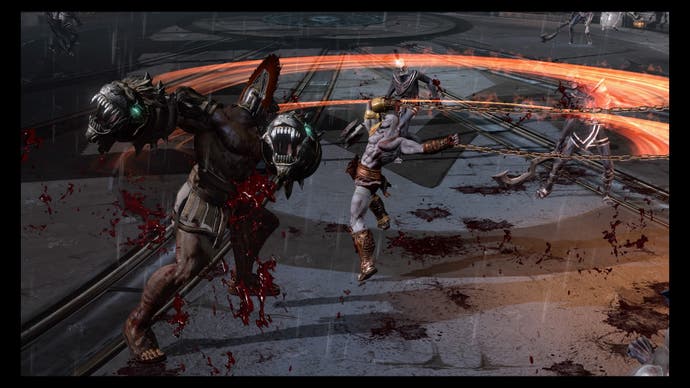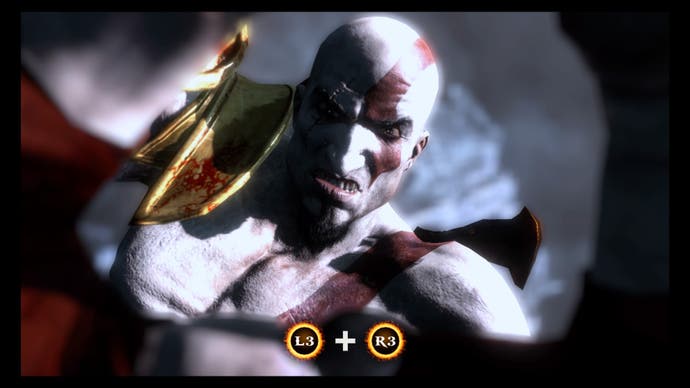Remembering the original God of War trilogy's biggest hooks
Chain of descent.
The "home depot axe", Sony Santa Monica nicknamed it during development, and for all the grandness of the title and the arcane butchery it facilitates, the new God of War's Leviathan Axe can indeed seem rather homely. It's an enchanted weapon, whirring back to your fist like a well-trained falcon after you hurl it across a clearing, just the thing when you need to shorten a giant or pin a Draugr to a wall. But with its worn leather handle and mottled blade, it also looks like something you might chop up kindling with in a quieter moment, something that might gather dust in a corner between outbreaks of deicide.
The axe says a lot in a little about Sony Santa Monica's attempt to defuse and humanise its protagonist, a shark-white hulk of scar tissue last seen punching his own father and thereby all of Ancient Greek civilisation to death in the wreckage of Mount Olympus. It's a tool of destruction, and you will do things with it that are every bit as eye-watering as in the previous games, but unlike the old Blades of Chaos, it doesn't feel like a means of mass murder. The use of triggers rather than face buttons to perform attacks adds an unfamiliar sluggishness, the sense that each blow is to be a touch more carefully weighed - and of course, there's the axe's relatively restricted reach and how this complements the introduction of a figure-hugging, over-the-shoulder camera.

In the third game, you could lacerate everything in a 360 degree arc, the Blades catching grotesquely for a fraction of a second on each individual body. Many video game weapons are as indiscriminate, but God of War is one of the few series that leans into the callousness of this, sometimes tossing civilians in amongst your enemies so that you have no choice but to slaughter them. In this year's reboot, you are less inclined or suited to "crowd control", more preoccupied with line of sight, and more vulnerable to strikes from the rear. This plays nicely, if predictably, into the game's newfound theme of emotional interdependence. Besides occasionally checking his dear old dad's apocalyptic urges, your son Atreus will shoot at and harass any enemies you can't see, a conscience who doubles as a source of covering fire.
I suspect I'm reading too much into the axe - I've yet to finish Sony Santa Monica's latest - but it's hard not to cast around for a bigger picture when you consider what the Blades of Chaos (variously renamed the Blades of Athena and Exile) represent in older outings and how much those games rely on their distinctive blend of frenzy and user-friendliness. On a more practical level, they're the prop that allows each game's swaggering cinematic direction and 3D combat system to rub along without tripping each other up. The generous horizontal reach of the Blades - wreathed in fire to make their position more obvious - allows the designer to change the camera's position frequently without quite throwing the player off. Sometimes the viewpoint nests, gargoyle-like, in the corner of a chamber; sometimes it hovers over the melee like a vulture; sometimes it pivots to frame some enormous creature while you mash up grunts in the foreground. Either way, you can generally carry on slicing and spinning without losing your bearings, secure in the knowledge that you are probably hitting something.
It's a less-sung instance of a third-person design tradition perfected by Capcom's original Devil May Cry, with its fixed perspectives that somehow never inconvenience an acrobatic protagonist - a tradition unfairly derided today, now that players have come to regard scripted camera movement as an "artificial" constraint. The third God of War takes things to an extreme by making the environment as mobile as the viewpoint. Amongst other mighty feats, you'll slay Titans vast enough to serve as battlefields themselves, the view pulling back till all you can see of Kratos is a rhythmic flicker of flame on a wilderness of heaving, stony skin.

If the Blades are integral to the "casual hardcore" vision of epic conflict dreamt up by David Jaffe in 2002, they're equally important as motifs in God of War's raucous carnival of misanthropy and self-destruction. The first three games are essentially a monster's revenge on the monsters who created him - a vendetta against the gods that begins with the sneering Ares, Kratos' old patron, and widens to engulf the gameworld itself and the very narrative fixtures of ancient Greek epic. Made abominable by the Olympian pantheon, Kratos' only means of retribution is to grow ever more abominable, swallowing up his tormentors and the proud marble reality they preside over.
Chained to the character's wrists by Ares, the Blades of Chaos naturally symbolise his servitude, but they are also the means by which you entrap other characters, wrapping the holy and unholy in their coils, pitting the instruments of your debasement against the very mythology that shackles you. So many of God of War's pornographic finishing moves see you ensnaring your adversaries with the Blades, stringing them up in order to rend them apart in scenes reminiscent of Inquisition torture manuals. In the third game, you'll hoist the god of the underworld over the river Styx, battering his brains against a cavern roof; in the first, you'll hook a hydra by trailing one chain behind you as you fall. In this regard, God of War's combat system is an ironic, if hardly subtle enactment of the plot's sheer depth of fatalism. It shows a loathsome man deepening his own ruin by dragging all things down to his level, one body part at a time, till there is at long last nothing left to rend.
It seems to be the fate of every long-running violent videogame franchise to sink gradually into self-disgust, and I've yet to play a more vicious example of that than God of War 3, a game that cheerfully guts whatever pretensions to heroism the series once harboured while bringing about the end of the world. All motivations save the destruction of Zeus are cast aside, and everything that lies outside the mayhem is ruthlessly skewered and dragged back in. The game's handling of sex, for instance, is a crude yet oddly squeamish extension of its bloodshed. Should you so desire, you can knock boots with Aphrodite, goddess of love, using the same context-sensitive button prompts you'll otherwise employ to lasso Olympian necks and harpoon torsos. (The scene in question is also notable for the way the camera suddenly develops an aversion to bodily fluids and penetration, after untold hours of stabbing and chopping.)

In the course of destroying its own universe, God of War 3 inevitably turns its eye back on the player as the ultimate manipulator, eclipsing even the hated Zeus. This idea is made all but explicit as Kratos prepares to finish off Poseidon, god of the ocean. Rather than swooping hungrily around the carnage as in previous boss sequences, the camera abruptly traps you inside Poseidon's head and, in essence, invites you to beat yourself to a pulp. This culminates with the player clicking the thumbsticks to jam Kratos' own thumbs into Poseidon's eyes, kicking you back out into the blessed sanctuary of third-person. In this way, rage against the gameworld is transformed into rage against the player, the unseen god yanking Kratos' chains. The sequence occurs towards the start of the story, but it really should have been the final scene - the moment when Kratos, having eaten death, beheaded the sun and killed his own creator, finally transfers his wrath to the frame through which his story is told.
And running through all that horror like a pair of writhing arteries, those Blades of Chaos. It's only fitting that the series itself has struggled to escape their chains: Sony Santa Monica has introduced many weapons over the intervening years but few are as irresistibly vicious, and several - the Cestus gauntlets, the claws of Hades - are essentially the Blades in another guise. This is even true of the Leviathan axe, as far removed as God of War 4's design strictures and Nordic setting may feel from the preceding armageddon. Next to the Blades, the axe is almost benign, a tool rather than an accursed attribute, hooked onto Kratos' armour rather than grafted to his arm. It is no longer a weapon that defines him, but as with the Blades of Chaos, it is one that comes all too readily to his hand. It thus captures in miniature the transition between epochs in the God of War saga, from nihilistic massacre simulator to a troubled redemption story. It is the emblem of a man who has learned to check his violence, but lost little of his appetite for it.









